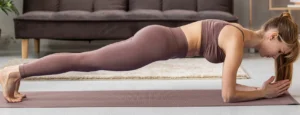The side plank lift exercise is a fantastic way to target and strengthen the core muscles, particularly the obliques and the muscles along the side of the body. This exercise involves balancing on one forearm and the side of the foot, while lifting the hips off the ground to create a straight line from head to toe. It is a challenging yet rewarding exercise that can be done by individuals of various fitness levels.
By performing side plank lifts regularly, you can expect to strengthen your core muscles, which are essential for stability and proper posture. The obliques, in particular, play a crucial role in rotational movements and lateral stability. Strengthening these muscles can improve your athletic performance and help protect against lower back pain and injuries.
In addition to targeting the core muscles, side plank lifts also engage other muscle groups, including the shoulders, glutes, and legs. The shoulders are actively involved in maintaining stability and supporting the body weight, while the glutes and legs work to maintain balance and alignment.
Another benefit of side plank lifts is their ability to improve overall body stability and balance. By challenging your core and working on maintaining a steady position, you train your body to have better control and stability during various daily activities and exercises. This can be especially beneficial for activities that require lateral movements or rotational stability.
Furthermore, side plank lifts can contribute to improved posture and alignment. As you engage and strengthen the core muscles, you develop a stronger support system for the spine, promoting proper alignment and reducing the risk of postural imbalances.
Lastly, side plank lifts can be a great addition to your fitness routine if you’re looking for exercises that don’t require any equipment. They can be done anywhere and anytime, making them a convenient option for busy individuals or those who prefer to work out at home.
Side Plank Lift – Instructions & Steps
- Lay on your side and prop yourself up with your elbow and forearm. Let your hip rest on the floor, and stack your legs
- Contract your core and obliques and lift yourself off the ground until your back is straight and you are in a side plank
- Hold, then return to start and repeat, then alternate to your other side
Benefits of Side Plank Lift
The side plank lift exercise offers numerous benefits for individuals looking to improve their fitness and overall well-being. By engaging the core muscles and promoting stability, this exercise can enhance posture, increase balance, and strengthen the muscles along the side of the body. Whether you’re an exercise novice or an experienced fitness enthusiast, incorporating side plank lifts into your routine can yield significant results.
Core Strength
Side plank lifts target the core muscles, including the obliques, rectus abdominis, and transverse abdominis. By strengthening these muscles, you can improve stability, enhance overall core strength, and support proper posture.
Improved Balance
Maintaining a side plank position challenges your balance and proprioception, which is your body’s awareness of its position in space. Regular practice can enhance your balance and stability, making everyday activities easier and reducing the risk of falls or injuries.
Enhanced Stability
Side plank lifts engage multiple muscle groups, including the shoulders, glutes, and legs, to maintain stability and alignment. Improved stability not only benefits your physical performance but also contributes to injury prevention and better overall body control.
Postural Alignment
By strengthening the core and promoting proper alignment, side plank lifts can help improve posture. As the core muscles become stronger, they provide better support for the spine, reducing the risk of postural imbalances and related discomfort.
Functional Strength
The side plank lift exercise mimics the lateral movements and rotational demands often encountered in daily activities and sports. By training these specific movement patterns, you can develop functional strength that translates into improved performance in various tasks and sports.
Versatile and Accessible
One of the key benefits of side plank lifts is their versatility and accessibility. You can perform this exercise anywhere, without the need for equipment. It is a convenient option for individuals with busy schedules or those who prefer to work out at home.
More About Side Plank Lift
The side plank lift is not typically considered a compound exercise. It is an isolation exercise that primarily targets the muscles of the core, particularly the obliques and the transverse abdominis. The side plank lift is a variation of the traditional side plank, where you lift your hips off the ground to create a side bridge.
During the side plank lift, the following muscle groups are primarily engaged:
- Obliques: The muscles on the sides of the waist are the main focus of this exercise, as they work to stabilize the side bridge and lift the hips.
- Transverse abdominis: The deep core muscles are engaged to support the spine and maintain stability during the side plank lift.
- Shoulders: The deltoid muscles work to support the upper body and maintain proper alignment during the exercise.
- Hip muscles: Various muscles around the hips, such as the glutes and hip abductors, are engaged to support the side bridge position.
- Stabilizing muscles: The muscles of the lower back and pelvis also contribute to stabilizing the side plank lift.
The side plank lift is an effective exercise for building core strength and stability, particularly in the lateral muscles of the core. It can help improve overall balance and posture and is often used in core strengthening and rehabilitation programs.
While the side plank lift primarily targets the core muscles, it is not classified as a compound exercise since it involves movement in a single plane and focuses on specific muscle groups. Compound exercises typically engage multiple muscle groups simultaneously and involve more dynamic movements.


